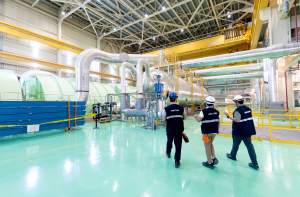How Abu Dhabi is accelerating the global transition to clean energy
The UAE capital is home to the world’s largest single-site solar farm, and the first multi-unit operating nuclear power plant in the Arab World, pioneering green hydrogen projects, and championing sustainable finance
The Noor Abu Dhabi solar plant lies barely an hour’s drive from the UAE capital. More than 3.3 million solar panels stretch out across the horizon, producing a combined 1.2GW of electricity.
It is currently the world’s largest single-site solar farm, integral to the emirate reaching an important milestone in February 2023 – meeting 80% of its power needs from non-emitting energy sources.
Projects like these are major contributors to the UAE Energy Strategy’s goal of achieving a countrywide 50% clean energy grid by 2050, in its bid to achieve net-zero emissions by mid-century.
But in greening its own grid, Abu Dhabi is also accelerating the global energy transition – advancing new low-carbon fuels, the circular economy, and sustainable finance.
Greening the energy grid
Noor Abu Dhabi is just one component in the emirate’s expanding clean energy network.
Established in 2006, Masdar is Abu Dhabi’s own renewable energy company, operating wind and solar farms across the emirate, the wider UAE, and over 40 other countries.
The company also hosts a range of top-level sustainability events under the banner of Abu Dhabi Sustainability Week, attracting climate and world leaders from across the globe.
Abu Dhabi is also home to the Barakah Nuclear Energy Plant– the first nuclear power plant in the Arab World. Currently running three reactors and with a fourth starting operations in 2024, the facility will soon produce a staggering 5.6GW of non-emitting energy– enough to power up to 1.7 million homes. It will also prevent the release of over 22.4 million tons of carbon emissions annually – equivalent to the emissions of 4.8 million cars.
“In just four years, the Barakah plant will have enabled the shift to 25% of the UAE’s electricity coming from a clean source,” says Mohamed Al Hammadi, MD and CEO of Emirates Nuclear Energy Corporation (ENEC), which develops the plant and represents the UAE Peaceful Nuclear Energy Program.
He adds that Barakah also fills the gaps in other sustainable sources: “Nuclear energy… generates significant volumes 24/7, even when the sun isn’t shining. This base load power is essential for national energy security, ensuring we can power industry, businesses, hospitals and homes around the clock.”
The plant was developed by the Emirates Nuclear Energy Corporation, working with a South Korean consortium led by Korea Electric Power Corporation. The partnership expanded to become a Joint Venture partnership in 2016, with a memorandum of understanding (MoU) between the two countries’ nuclear industries being signed in 2023 to accelerate the achievement of net zero.
ENEC has also signed an MoU with Romanian Nuclearelectrica to cooperate on nuclear power, alongside a UAE pledge to help fund new reactors in the country in a US-led partnership.
The plant has another important role to play too – helping to produce crucial new sustainable fuels.
MD and CEO of Emirates Nuclear Energy Corporation (ENEC)
MD and CEO of Emirates Nuclear Energy Corporation (ENEC)
Pioneering alternative fuels
“Barakah is a stepping stone in the UAE’s plans to become a global hydrogen hub,” says Al Hammadi. The UAE has aims to supply 25% of major global hydrogen markets, producing 14-22 million tons annually by 2050.
“Hydrogen is critical to the [energy] transition,” says Mussabbeh Al Kaabi, Executive Director, Low Carbon Solutions and International Growth Directorate, ADNOC. “Experts estimate it could meet around 18% of global energy demand by 2050.”
It is seen as especially important for difficult-to-decarbonize sectors like aviation, shipping, and heavy industry, which have so far proven challenging to electrify. Zero-carbon green hydrogen can be produced as a by-product of renewable energy production, including nuclear.
ADNOC is working with Masdar and bp to develop hydrogen production – which is yet to reach commercialization – in both the UK and UAE. The partnership is also exploring ‘blue hydrogen’, which can be produced using Carbon Capture Utilization and Storage (CCUS).
Executive Director, Low Carbon Solutions and International Growth Directorate, ADNOC
Executive Director, Low Carbon Solutions and International Growth Directorate, ADNOC
Al Kaabi says the fuel is important to the energy transition because it is “cost competitive, has a lower carbon intensity than most fuels on the market, and it creates demand for this type of energy at scale, supporting the commercialization of green hydrogen.”
ADNOC is also working to progress the UAE’s circular economy ambitions, codified in its Circular Economy Policy. The company is working with Masdar, bp, Tadweer (Abu Dhabi Waste Management Company) and Etihad Airways to explore sustainable aviation fuel created from municipal solid waste and renewable hydrogen.
These projects are pioneering critical approaches to clean energy. Other initiatives are advancing sustainable finance.
Financing sustainable power
Clean Energy Certificates (CECs) have been available to purchase from EWEC since October 2021, in a policy introduced by the Abu Dhabi Department of Energy.
One CEC is equal to 1MW of clean energy, “enabling Abu Dhabi-based companies to demonstrate their use of clean electricity,” while directing investment towards sustainable energy, explains Al Hammadi.
ADNOC announced that it is using the grid energy from solar and nuclear power to supply all of its onshore operations. ENEC’s Barakah Nuclear Energy Plant generates around 80% of the power for the certificates, with the remaining 20% coming from solar sources.
Meanwhile, the Abu Dhabi Global Market (ADGM) Academy runs the School of Sustainable Finance, educating investors on how to pursue sustainability within a financial context.
These initiatives lean on Abu Dhabi’s twin status as climate champion and global finance hub, helping to enact a sea change towards climate-friendly investment.
Accelerating the energy transition
Abu Dhabi has made remarkable progress in greening its electricity supply. What is more remarkable is how far it is advancing the global energy transition in the process.
Discover how you can
thrive in Abu Dhabi.
